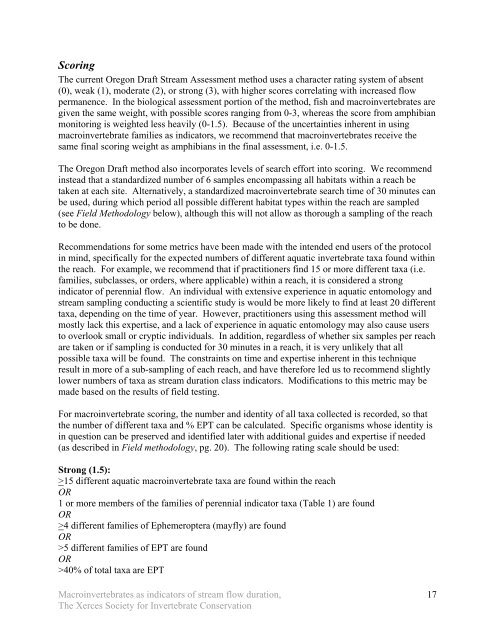Using Aquatic Macroinvertebrates as Indicators of Stream Flow ...
Using Aquatic Macroinvertebrates as Indicators of Stream Flow ...
Using Aquatic Macroinvertebrates as Indicators of Stream Flow ...
Create successful ePaper yourself
Turn your PDF publications into a flip-book with our unique Google optimized e-Paper software.
ScoringThe current Oregon Draft <strong>Stream</strong> Assessment method uses a character rating system <strong>of</strong> absent(0), weak (1), moderate (2), or strong (3), with higher scores correlating with incre<strong>as</strong>ed flowpermanence. In the biological <strong>as</strong>sessment portion <strong>of</strong> the method, fish and macroinvertebrates aregiven the same weight, with possible scores ranging from 0-3, where<strong>as</strong> the score from amphibianmonitoring is weighted less heavily (0-1.5). Because <strong>of</strong> the uncertainties inherent in usingmacroinvertebrate families <strong>as</strong> indicators, we recommend that macroinvertebrates receive thesame final scoring weight <strong>as</strong> amphibians in the final <strong>as</strong>sessment, i.e. 0-1.5.The Oregon Draft method also incorporates levels <strong>of</strong> search effort into scoring. We recommendinstead that a standardized number <strong>of</strong> 6 samples encomp<strong>as</strong>sing all habitats within a reach betaken at each site. Alternatively, a standardized macroinvertebrate search time <strong>of</strong> 30 minutes canbe used, during which period all possible different habitat types within the reach are sampled(see Field Methodology below), although this will not allow <strong>as</strong> thorough a sampling <strong>of</strong> the reachto be done.Recommendations for some metrics have been made with the intended end users <strong>of</strong> the protocolin mind, specifically for the expected numbers <strong>of</strong> different aquatic invertebrate taxa found withinthe reach. For example, we recommend that if practitioners find 15 or more different taxa (i.e.families, subcl<strong>as</strong>ses, or orders, where applicable) within a reach, it is considered a strongindicator <strong>of</strong> perennial flow. An individual with extensive experience in aquatic entomology andstream sampling conducting a scientific study is would be more likely to find at le<strong>as</strong>t 20 differenttaxa, depending on the time <strong>of</strong> year. However, practitioners using this <strong>as</strong>sessment method willmostly lack this expertise, and a lack <strong>of</strong> experience in aquatic entomology may also cause usersto overlook small or cryptic individuals. In addition, regardless <strong>of</strong> whether six samples per reachare taken or if sampling is conducted for 30 minutes in a reach, it is very unlikely that allpossible taxa will be found. The constraints on time and expertise inherent in this techniqueresult in more <strong>of</strong> a sub-sampling <strong>of</strong> each reach, and have therefore led us to recommend slightlylower numbers <strong>of</strong> taxa <strong>as</strong> stream duration cl<strong>as</strong>s indicators. Modifications to this metric may bemade b<strong>as</strong>ed on the results <strong>of</strong> field testing.For macroinvertebrate scoring, the number and identity <strong>of</strong> all taxa collected is recorded, so thatthe number <strong>of</strong> different taxa and % EPT can be calculated. Specific organisms whose identity isin question can be preserved and identified later with additional guides and expertise if needed(<strong>as</strong> described in Field methodology, pg. 20). The following rating scale should be used:Strong (1.5):>15 different aquatic macroinvertebrate taxa are found within the reachOR1 or more members <strong>of</strong> the families <strong>of</strong> perennial indicator taxa (Table 1) are foundOR>4 different families <strong>of</strong> Ephemeroptera (mayfly) are foundOR>5 different families <strong>of</strong> EPT are foundOR>40% <strong>of</strong> total taxa are EPT<strong>Macroinvertebrates</strong> <strong>as</strong> indicators <strong>of</strong> stream flow duration,The Xerces Society for Invertebrate Conservation17
















